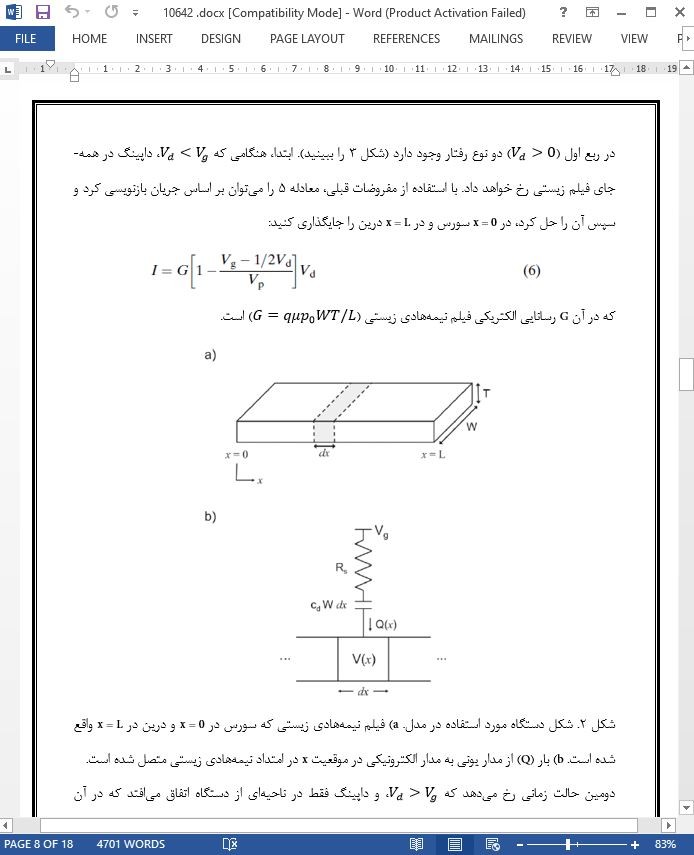
بررسی رفتار گذرا و حالت پایدار ترانزیستور الکتروشیمیایی زیستی
در سال های اخیر، ترانزیستورهای الکتروشیمیایی زیستی (OECTها) به عنوان تجهیزات جذاب برای انواع برنامه های کاربردی به ویژه موضوع حسگرها مطرح شده اند،. اگر چه مشخصه های الکتریکی OECTها با مشخصه های ترانزیستورهای اثر میدانی زیستی معمولی مشابه است، اما هنوز مدل های مناسب OECT گسترش نیافته است. به طور خاص، شناخت کمی در مورد ویژگی های گذرای OECTها وجود دارد، که توسط یک فعل و انفعال پیچیده بین جنبش (حرکت) یونی و الکترونیکی تعیین می شود. در این مقاله یک مدل ساده ارائه شده است تا پاسخ حالت ماندگار و گذرای OECTها با در نظر گرفتن این تجهیز از نظر مدار الکترونیکی و یونی مجددا بررسی شود. یک عبارت تحلیلی ساده میتواند برای مناسب سازی ویژگی های حالت پایدار OECT مورد استفاده قرار گیرد. برای حالت گذرا، مقایسه با داده های تجربی امکان برآورد تغییر محل حفره در پلی (اتیلن دی اکسیفن 3و 4) ناخالص شده با پلی (سولفونات استایرن) فراهم کرده است. این کار راه را برای بهینه سازی منطقی OECTها آسان کرده است. (در این مقاله منظور از داپینگ یا داپ شدن، فرآیند افزودن ناخالصی شیمیایی است)
1. مقدمه
حوزه الکترونیک زیستی به طور قابل توجهی در 20 سال گذشته عمدتا به دلیل بسیاری از ویژگی های مناسب نیمههادیهای زیستی گسترش یافته است، این ویژگی ها عبارتند از: هزینه کم، پردازش و تنظیم آسان از طریق شیمی ترکیبی. [1] در میان نیمه هادی ها، ترانزیستورهای زیستی با لایه نازک (OTFTها) به دلیل کارایی در الکترونیک (مدار) چاپی توجه زیادی را به خود جلب کرده است. [2] در زیر مجموعه نیمه هادی ها، ترانزیستور الکتروشیمیایی زیستی (OECTها) با توجه به نحوه ساخت ساده و کار در ولتاژهای پایین خود را از دیگر ترانزیستورها متمایز کرده است [3]. توانایی کار در محیط های مرطوب (آبی) و ادغام با میکروفلودیک ها (سیال ها)، OECTها را برای انواع برنامه های کاربردی، به خصوص حسگرها تبدیل به یک انتخاب مناسب کرده است [4].
3. نتیجه گیری
در این مقاله ما یک مدل ارائه کردیم که رفتار حالت پایدار و گذرای OECTها را توصیف می کند. با استفاده از یک روش دو مداری، ماهیت یونی و الکترونیکی OECTها بررسی شد و رفتار دستگاه واقعی بازسازی گردید. این مدل در زمان استفاده برای مناسب سازی رفتار معمولی دستگاه در حالت پایدار بسیار قابل قبول بود. جریان گذرای سورس درین وجود دو نوع رفتار خاص کاهش یکنواخت یا افزایش و بهبود را پیش بینی کرده بود. با تغییر ولتاژ درین، هر دو نوع پاسخ در PEDOT:PSS OECT نشان داده شد. این مدل نشان می دهد که تنظیم مناسب پارامترهای دستگاه چگونه می تواند به عنوان ابزاری برای مینیمم کردن زمان پاسخ OECTها مورد استفاده قرار گیرد. پارامترهای معمولی مواد استخراج شده از مقایسه با آزمایش، تخمین معقول و منطقی برای PEDOT:PSS است. به طور کلی، این مدل ساده یک ابزار قدرتمند برای طراحی OECTها می باشد، که با تغییراتی می تواند برای طراحی های بسیار متفاوت ترانزیستورها مورد استفاده قرار گیرد.
In recent years, organic electrochemical transistors (OECTs) have emerged as attractive devices for a variety of applications, particularly in the area of sensing. While the electrical characteristics of OECTs are analogous to those of conventional organic field effect transistors, appropriate models for OECTs have not yet been developed. In particular, little is known about the transient characteristics of OECTs, which are determined by a complex interplay between ionic and electronic motion. In this paper a simple model is presented that reproduces the steady-state and transient response of OECTs by considering these devices in terms of an ionic and an electronic circuit. A simple analytical expression is derived that can be used to fit steady-state OECT characteristics. For the transient regime, comparison with experimental data allowed an estimation of the hole mobility in poly(3,4-ethylenedioxythiophene) doped with poly(styrene sulfonate). This work paves the way for rational optimization of OECTs.
1. Introduction
The field of organic electronics has grown significantly in the past 20 years largely due to the many desirable properties of organic semiconductors such as low cost, ease of processing and tunability through synthetic chemistry.[1] Among organic semiconductor devices, organic thin film transistors (OTFTs) have attracted considerable interest for their application in printed electronics.[2] Within the subset of OTFTs, organic electrochemical transistors (OECTs) have distinguished themselves in recent years given their simple fabrication and low voltage operation.[3] The ability to operate in aqueous environments and the integration with microfluidics make OECTs excellent candidates for a variety of applications, especially in the area of sensing.[4]
3. Conclusions
In this paper we have presented a model that describes the steady-state and transient behavior of OECTs. Utilizing a two circuit approach, the ionic and electronic nature of OECTs was accounted for and realistic device behavior was reproduced. The model showed excellent agreement when used to fit typical device behavior at steady-state. The source-drain current transient was predicted to exhibit two types of characteristic behavior: monotonic decay or spike-and-recovery. Both types of response were demonstrated in a PEDOT:PSS OECT by variation of the drain voltage. The model shows how tuning of the appropriate device parameters can be used as a means to minimize the response time of OECTs. Typical materials parameters extracted from comparison with experiment were reasonable estimates for the mobility of PEDOT:PSS. In general, this simple model is a powerful tool for design of OECTs, which can be modified to account for many variations in device design.

1. مقدمه
2. تشریح مطالب و نتایج آن
2.1. مدل دستگاه
2.2. رفتار حالت پایدار
2.3. رفتار گذرا
3. نتیجه گیری
4. آزمایش
1. Introduction
2. Results and Discussion
2.1. Device Model
2.2. Steady-State Behavior
2.3. Transient Behavior
3. Conclusions
4. Experimental
- ترجمه فارسی مقاله با فرمت ورد (word) با قابلیت ویرایش، بدون آرم سایت ای ترجمه
- ترجمه فارسی مقاله با فرمت pdf، بدون آرم سایت ای ترجمه
